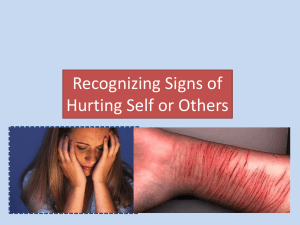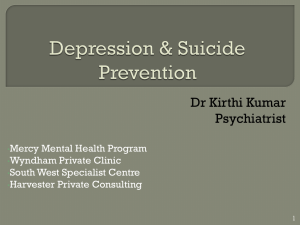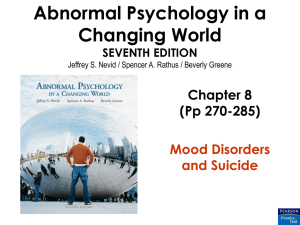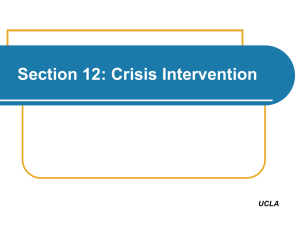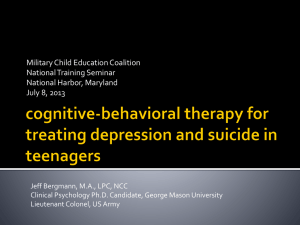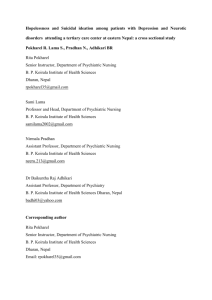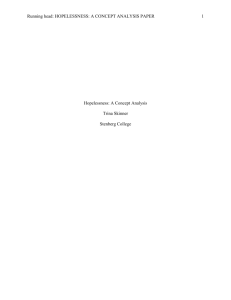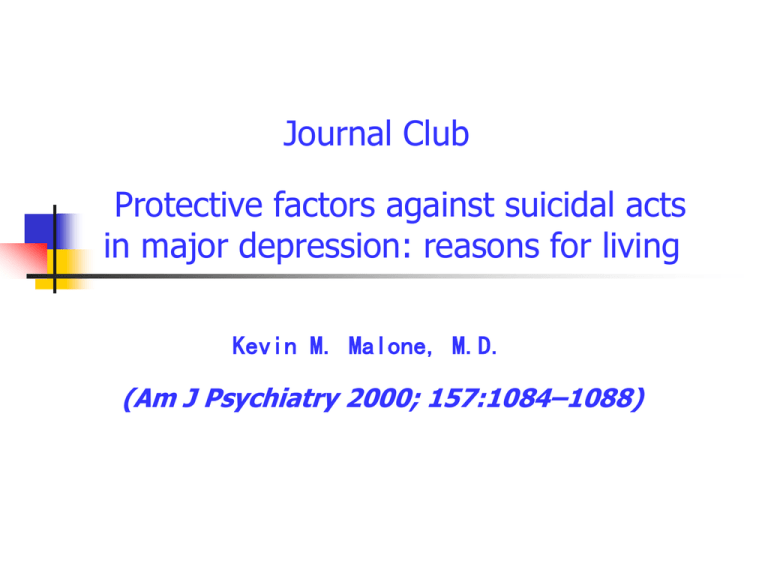
Journal Club
Protective factors against suicidal acts
in major depression: reasons for living
Kevin M. Malone, M.D.
(Am J Psychiatry 2000; 157:1084–1088)
Background
Over 30,000 people a year commit suicide
in the United States.
Prior attempted suicide and hopelessness
are the most powerful clinical predictors of
future completed suicide.
Background
previously hypothesized: a stressdiathesis model for the expression of both
suicidal behavior and completed suicide.
defined a trigger domain that is related to
stressors, and therefore is state
dependent, and a diathesis or threshold
domain, which is more trait dependent.
Background
there may also be significant modulation by
religious or cultural variables.
A seldom-posed but important question
Some of these protective social or cultural
factors are reflected in a scale designed to
assess reasons for living—the Reasons for
Living Inventory.
Background
The Reasons for Living Inventory
a self-report instrument that measures
beliefs that may contribute to the inhibition
of suicidal behavior.
It is composed of six factors: survival and
coping beliefs, responsibility to family, childrelated concerns, fear of suicide, fear of
social disapproval, and moral objections to
suicide.
Background
The Reasons for Living Inventory
These factors are composites of true or false
responses to statements
“Life is all we have and is better than nothing,”
“I am afraid of the unknown,”
“My religious beliefs forbid it,”
which have apparent influences from culture,
religion, and sociopolitical attitudes.
Its validity and reliability has been documented.
Objective
Verify hypothesis:
more reasons for living would be associated
with fewer and less intense suicidal acts or
less suicidal ideation during a depressive
episode.
reasons for living would correlate inversely
with hopelessness, suicidal ideation, and
subjective depression—“clinical suicidality”—
and therefore would be an important clinical
modulator of risk for suicidal acts.
Method
examined correlates of a history of suicide
attempts in patients with major depression.
Patients with or without such a history were
compared.
Method
Subjects :
were recruited from patients admitted to two
urban university psychiatric hospitals ,
aged between 18 and 80 years ,
met the DSM-III-R criteria for current major
depressive episode during the intake clinical
assessment ,
were free of severe, unstable medical and
neurologic disorders
Method
The nonparticipants :
did not differ significantly from the research
participants on key demographic and clinical
variables, such as age, sex, race, severity of
depression on admission, or number of
previous depressive episodes.
were more likely to have been substance
abusers
Method
Evaluation tool :
SCID-P(Diagnosis)
Hamilton Depression Rating Scale (objective )
the Beck Depression Inventory(subjective)
the Hopelessness Scale (Hopelessness)
the Brief Psychiatric Rating Scale (General
psychopathology )
the Reasons for Living Inventory
Method
Evaluation tool :
the St. Paul Ramsay Life Experience Scale and
Recent Life Changes Questionnaire (quantity and
severity of life events )
compiled a comprehensive lifetime history of
lifetime suicidal acts
the Scale for Suicide Ideation(current ideation)
the Suicide Intent Scale (intent at the most
lethal and most recent suicide attempt)
the Medical Lethality Scale ( medical injury
resulting from suicidal acts)
Results
Demographic and Clinical Features
Failed to distinguish :
Age, sex , education , religion ;
Number(p=0.053), duration , and objective
severity of depressive episodes;
The distribution of unipolar versus bipolar
depression (there were only three patients
with bipolar disorder in the study group).
Results
Demographic and Clinical Features
the suicide attempters reported
significantly greater subjective depression,
hopelessness, and suicidal ideation than
the nonattempters
Race :the depressed non-Caucasians
were significantly less likely to have
attempted suicide than were the
depressed Caucasians.
Results
Reasons for Living
The depressed patients who had not
attempted suicide scored significantly
higher on total reasons for living ,
survival and coping beliefs, fear of social
disapproval, and moral objections to
suicide than the suicide attempters.
Results
Reasons for Living
Fear of suicide also was statistically
different between the attempters and
nonattempters, but it was not a powerful
a discriminating factor.
When the analysis of child-related
concerns was limited to the subjects
with offspring, the nonattempters had
nonsignificantly more child-related
concerns than the suicide attempters.
Results
Correlation analysis
Pearson correlation analysis:
the total score for reasons for living was
significantly inversely correlated with the
scores for hopelessness (r=–0.58, N=67,
p<0.0001), suicidal ideation (r=–0.48,
N=68, p<0.0001), and subjective depression
(Beck Depression Inventory) (r=–0.42,
N=66, p<0.0005).
Results
Correlation analysis
Canonical correlation analysis:
the relationship between reasons for living
and the sum of the scores for hopelessness,
subjective depression, and suicidal ideation—
a measure of “clinical suicidality.” Clinical
suicidality was highly significantly inversely
correlated with reasons for living (canonical
correlation=–0.64, likelihood ratio=0.59,
df=3, 59, N=62,p<0.0001).
Discussion
consistent with borderline personality disorder
A higher total score for reasons for living was
associated with less hopelessness(may
modulate the threshold for acting on suicidal
thoughts)
Higher hopelessness scores VS life events (
suggests that the subjective perception of
stressful life events may be more germane to
suicidal expression than objective quantitative
measures of such events.)
Discussion
Chiles reported disparate findings.
Chinese patients : depression, rather than
hopelessness, was related to suicidal intent.
They postulated that the connection between
hopelessness and intent may not have been so
relevant for their Chinese subjects because of
differing moral or cultural experiences and
beliefs, whereby the enduring attitude is that
one has little control over adverse events.
Discussion
Reasons for living, like hopelessness, may
reflect a cultural or environmental
component in the suicide threshold and
may contribute to variation in suicide rates
among different cultures.
Discussion
Hopelessness
is difficult to categorize as either environmental
or biological, as an acute clinical trigger, or as a
chronic threshold-influencing factor.
Clinically, the degree of hopelessness can vary
considerably in an individual.
Yet, even when acute hopelessness remits, for
example upon resolution of major depression,
significantly higher levels of hopelessness
remain in patients with past suicide attempts.
Discussion
Low scores for reasons for living
may also be considered to behave in a similar
fashion. Although it measures a different
construct, the total score for reasons for living
correlates inversely with the construct of
“clinical suicidality”—hopelessness, subjective
depression, and suicidal ideation—and may
hypothetically vary within an individual,
depending on whether or not external triggers
are present.
Discussion
Number of depressive episodes
a somewhat, but nonsignificantly, higher.
Repeated exposure to depression, rather than
the duration of depression, may be an
additional risk factor for suicidal acts in patients
who experience suicidality when depressed.
This possibility underscores the importance of
early and adequate antidepressant treatment
and prophylactic treatment against further
depressive episodes.
Discussion
Religion (not differentiate),
the scores for moral objections to suicide
(differed strongly).
greater moral objection to suicide protected
against higher-lethality suicidal acts.
Reasons for living may be a more sensitive
indicator of enduring moral/religious beliefs
than is “religion of origin” per se.
Discussion
Whether race, culture, religion (among
various ethnic groups).
suicidal thoughts and behavior:
acculturated Hispanics (greater risk) ,
rate of suicide :Mexican Americans (a
lower), black adolescents is rising , blacks
remains (well below )
It may be that “live religion” supports
reasons for living, which in turn provide
protection against suicide in times of
stress.
Discussion
Caution is required when generalizing from
our results(the study group was small and
confined to patients with major depression).
Specific studies of substance abusers need to
be conducted to identify specific risk factors
for suicidal acts in this high-risk group.(the
nonparticipants)
It would also be important to replicate our
findings in larger and more diverse clinical
groups.
Discussion
The total score for reasons for living was
inversely correlated with the sum of the
scores for hopelessness, subjective
depression, and suicidal ideation( “clinical
suicidality”).
Discussion
Perhaps treatment strategies that reduce
clinical suicidality, or that increase awareness
of reasons for living, may be complementary,
and they should be explored.
Reasons for living should be included in the
clinical assessment of suicidal patients, and
treatment strategies that support reasons for
living and instill hope during times of stress,
such as a major depressive episode, need to
be developed.
Conclusions
During a depressive episode, the subjective
perception of stressful life events may be more
germane to suicidal expression than the objective
quantity of such events.
A more optimistic perceptual set, despite equivalent
objective severity of depression, may modify
hopelessness and may protect against suicidal
behavior during periods of risk, such as major
depression.
Assessment of reasons for living should be included in
the evaluation of suicidal patients.
Comments
Method
The design of the study was group control, I have
some questions about the enrollment of the
patients.
1. The time range of the study was not told.
2. the explanation of “the nonparticipant” was
not very clear, such as the amount of cases,
the reason why some people didn’t get involve,
and the situation about suicide attempt in “the
nonparticipant” was unclear too.
Comments
A
(patients who meet
the include criteria in
studied time period)
B
(the participants)
84
D (SA)
45 *
C
(the nonparticipants)
E (N SA)
39 *
assess
Flowchart
Comments
Method
3. Samples came from two different hospital,
however the distribution of the patient in
them wasn’t described.
The sample size was small, further more, the
process of case enrollment was not introduced
in detail, I think the representatives of
samples maybe face doubts.
Comments
Method
Instrument
This study used a series of scale with good
reliability and validity .
But I am not clear whether the length of the paper
was restricted or not . the author didn’t give
message about the evaluating members ( the
consistency).
Comments
Method
Statistics
t-test and chi-square test were used when
comparing the SA patients and controls.
I wonder would it be better if advanced
statistics method (such as logistics regression)
were adopted ? I guess it maybe the author
focus on the protect factors ( reasons for
living)…
Comments
Results
I fell uncertain about some of the results :
1. From table 1, what I concluded is Non-Caucasian
depression patients suffer more suicide attempts
than Caucasian. But in the paper is “ Of note, the
depressed Non-Caucasians were significantly
less likely to have attempted suicide than were
the depressed Caucasians. “
I want to know whether I had misunderstanded
or something was wrong about the printing of the
table 1.
Comments
Results
2. every variables in table 1 were described in the
article except the marital status variable.
This paper had mentioned about “ duration of
depressive episodes ”, however no data were
shown and I couldn’t find corresponding test
method and P value in this paper.
Comments
Advantage
Focus on the protective factors.
The new discovery
The method of this study can be replicate .
Disadvantage
representativeness of samples
Comments
Enlightenment to domestic research
The article proposed “a seldom –posed but
important question is not why depressed patients
want to commit suicide, but why they want to live”
which worth attention, because we usually used to
focus on the searching of risk factors, and we want
to provide prevention depend on the decrease or
elimination of risk factors, and neglect the
exploration of protect factors, this paper have gave
us a new direction and shown us another angle of
view when designing a research.
Comments
Enlightenment to domestic research
The article has some new discovery, which deserve
in-depth study and replication study with larger
sample size. The study may extended to other
disorders(such as BD and SP)
谢 谢!



